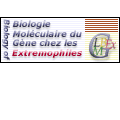
|
|















|
International Summer School
From Genome to Life:
Structural, Functional and Evolutionary approaches
PAAR Christine |
|
Technical University of Graz, Institute Of Biotechnology; Genetics Group, Petersgasse 12/1, Graz 8010, Austria title: Investigating features of a gdsl-hydrolase Christine Paar and Helmut Schwab Similarity within proteins of the GDSL family can be found predominantly in five blocks[1], which are spread over the whole sequence. Three of these regions harbor the catalytically active residues, known to be serine, histidine and aspartic acid. Bacterial lipolytic enzymes grouped as GDSL members display the tetrapeptide consensus motif close to the N-terminus[2] whereat this box around the active site serine consensus can be viewed as an arrangement of polar and negatively charged amino acids. In the investigated protein Bg EstA 81 from Burkholderia gladioli, formerly known as Pseudomonas marginata, the active site serine carrying consensus motif as well as it's vicinity are targets of site directed mutagenesis experiments. The aim is to identify additional residues potentially involved in the catalytic mechanism. Screening experiments with fluorogenic enzyme substrates revealed that the water-soluble carboxylic acid esters of HPTS (1-hydroxypyrene - 3,6,8 - trisulfonic acid trisodium salt) are readily hydrolyzed by the esterase EstA 81 from Burkholderia gladioli. It was interesting that HPTS derivatives containing an acid moiety with longer chains were better hydrolysed than those with short chained acids. As the ability to hydrolyze long-chain acylglycerols is a typical feature of lipases we assume that the amino acid composition and charge distribution in the GDSL consensus motif determines the substrate binding and specificity in this member of new lipolytic enzymes. In view of the catapult model hypothesis[3] we want to ascertain the contribution of the electrostatic environment to the substrate profile and try to find an outstanding ester substrate for the screening and identification of new members of the GDSL-family by site specific mutagenesis experiments and evolutionary programs. [1] Upton, C. and Buckley, J. T.(1995) [2] Arpigny, J. L. and Jaeger, K.-E. (1999) [3] Petersen M.T.N.; Fojan P.; Petersen S.B (2001) |